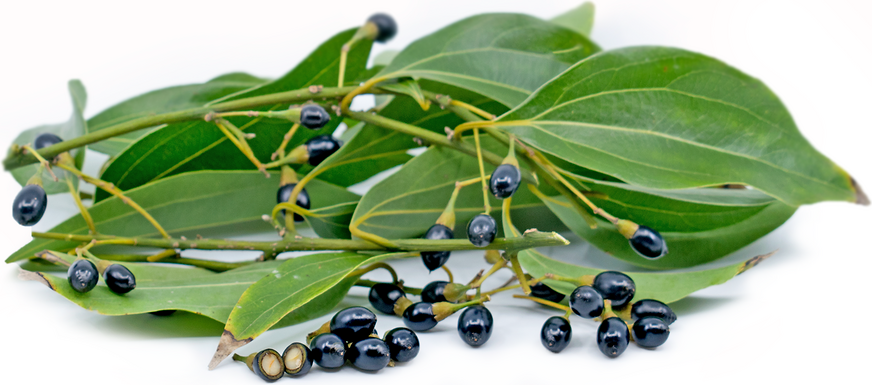


Cinnamon Tree Berries
Estimated Inventory, lb : 0
Description/Taste
Cinnamon buds have a clove-like appearance. They have a short stem attached to a round bud which consists of the flower remnants curled around the immature and not fully developed fruit of the cinnamon tree. They are harvested over a period of a few weeks, just after the creamy white flowers have fallen away and just as the seeds, or fruits, begin to develop beneath the remaining calyx. The small brown buds are only 1 centimeter long and are air dried, turning a dark brown almost black color. They offer a taste that is earthy, floral, and peppery with a milder, sweet cinnamon flavor.
Seasons/Availability
Cinnamon buds are available year-round.
Current Facts
Cinnamon buds, also known as Cassia buds, are the dried budding seeds of the cinnamon tree. Botanically, there are two different varieties of cinnamon tree that produce both the buds as well as the bark, Cinnamomum verum and Cinnamomum aromaticum. To distinguish between the two, C. verum is typically referred to as ‘cinnamon’ and C. aromaticum is usually referred to as ‘cassia’. The buds are used as a whole spice, much like the dried bark of the same tree.
Nutritional Value
Very little research has been done on the nutritional value of Cinnamon buds. Cinnamon itself contains manganese, fiber, calcium, iron, and vitamin K. It also offers antioxidant benefits.
Applications
Cinnamon buds are used whole or ground, like black peppercorns, in a spice grinder or with a mortar and pestle. Put Cinnamon buds in the pepper grinder alone or with different varieties of peppercorns to impart a different flavor into dishes. Whole Cinnamon buds are used in pickling recipes, stews, and brines for meat or poultry. They are used to flavor curries and spicy meat dishes in India. Ground Cinnamon buds are often used in powdered masala mixes and are particularly used in different regional recipes like Parsi dhansakh, Malvani and Maharastrian powdered masala. They can be used as a substitute for cinnamon, ground fresh when ready to use. Use generously in desserts with apples, pears, stone fruit, berries or chocolate. The whole buds can be used in place of cloves for making spiced orange pomanders for the holidays or used in mulling spice blends and teas. Store Cinnamon buds in an airtight container for up to one year.
Ethnic/Cultural Info
Cinnamon buds are most famously used in recipes for authentic pfeffernusse, which are small, hard German cookies flavored with a variety of different spices, and traditionally made during Christmastime in Germany. They are also a featured spice in recipes for ‘cassia bud pickles’ dating back to the late 19th century.
Geography/History
Cinnamomum verum, sometimes referred to as ‘true cinnamon’ is native to Sri Lanka, formerly known as Ceylon, whereas cassia or C. aromaticum is native to southern China, and Burma. Other, lesser known and not commercially cultivated species of cassia include Cinnamomum burmannii and Cinnamomum loureirii. The spices date to 3000 BCE, when the first references to cassia were made in Chinese literature. Cinnamon was brought to Egypt during the reign of Queen Hatshepsut during the 16th century BCE, and both cinnamon and cassia were included as ingredients for anointing oil in the Bible's Exodus 30:22-25. Today, Cinnamon buds are primarily harvested for commercial use in the main cinnamon and cassia producing regions of Sri Lanka, Indonesia, China, Vietnam and Burma, and are shipped around the world. Cinnamon, or Cassia buds, can be found in specialty stores and through online vendors.
Recipe Ideas
Recipes that include Cinnamon Tree Berries. One
| Barefeet in the Kitchen |
|
German Pepper Nut Cookies |
| The Spice House |
|
Cassia Bud Sweet Pickles |
| My Grandma's Recipes |
|
Cassia Bud Pickles |




